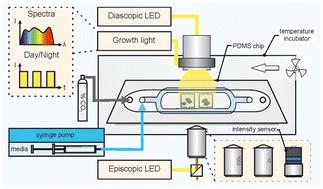Our official English website, www.x-mol.net, welcomes your
feedback! (Note: you will need to create a separate account there.)
A microfluidic system for the cultivation of cyanobacteria with precise light intensity and CO2 control: enabling growth data acquisition at single-cell resolution
Lab on a Chip ( IF 6.1 ) Pub Date : 2024-09-30 , DOI: 10.1039/d4lc00567h Lennart Witting, Johannes Seiffarth, Birgit Stute, Tim Schulze, Jan Matthis Hofer, Katharina Nöh, Marion Eisenhut, Andreas P. M. Weber, Eric von Lieres, Dietrich Kohlheyer
Lab on a Chip ( IF 6.1 ) Pub Date : 2024-09-30 , DOI: 10.1039/d4lc00567h Lennart Witting, Johannes Seiffarth, Birgit Stute, Tim Schulze, Jan Matthis Hofer, Katharina Nöh, Marion Eisenhut, Andreas P. M. Weber, Eric von Lieres, Dietrich Kohlheyer

|
Quantification of cell growth is central to any study of photoautotrophic microorganisms. However, cellular self-shading and limited CO2 control in conventional photobioreactors lead to heterogeneous conditions that obscure distinct correlations between the environment and cellular physiology. Here we present a microfluidic cultivation platform that enables precise analysis of cyanobacterial growth with spatio-temporal resolution. Since cyanobacteria are cultivated in monolayers, cellular self-shading does not occur, allowing homogeneous illumination and precise knowledge of the photon-flux density at single-cell resolution. A single chip contains multiple channels, each connected to several hundred growth chambers. In combination with an externally applied light gradient, this setup enables high-throughput multi-parameter analysis in short time. In addition, the multilayered microfluidic design allows continuous perfusion of defined gas mixtures. Transversal CO2 diffusion across the intermediate polydimethylsiloxane membrane results in homogeneous CO2 supply, with a unique exchange-surface to cultivation-volume ratio. Three cyanobacterial model strains were examined under various, static and dynamic environmental conditions. Phase-contrast and chlorophyll fluorescence images were recorded by automated time-lapse microscopy. Deep-learning trained cell segmentation was used to efficiently analyse large image stacks, thereby generating statistically reliable data. Cell division was highly synchronized, and growth was robust under continuous illumination but stopped rapidly upon initiating dark phases. CO2-Limitation, often a limiting factor in photobioreactors, was only observed when the device was operated under reduced CO2 between 50 and 0 ppm. Here we provide comprehensive and precise data on cyanobacterial growth at single-cell resolution, accessible for further growth studies and modeling.
中文翻译:

用于培养蓝藻的微流体系统,具有精确的光强度和 CO2 控制:能够以单细胞分辨率采集生长数据
细胞生长的定量是任何光合自养微生物研究的核心。然而,传统光生物反应器中的细胞自阴影和有限的 CO2 控制导致异质条件,从而掩盖了环境和细胞生理学之间的明显相关性。在这里,我们提出了一个微流体培养平台,该平台能够以时空分辨率精确分析蓝藻生长。由于蓝藻是在单层中培养的,因此不会发生细胞自着色,从而可以在单细胞分辨率下获得均匀的照明和光子通量密度的精确信息。单个芯片包含多个通道,每个通道连接到数百个生长室。结合外部施加的光梯度,该设置可在短时间内实现高通量多参数分析。此外,多层微流体设计允许连续灌注定义的气体混合物。CO2 跨中间聚二甲基硅氧烷膜的横向扩散导致 CO2 供应均匀,具有独特的交换表面与培养体积比。在各种静态和动态环境条件下检查了三种蓝藻模型菌株。通过自动延时显微镜记录相差和叶绿素荧光图像。深度学习训练的细胞分割用于有效地分析大型图像堆栈,从而生成统计上可靠的数据。细胞分裂高度同步,在连续光照下生长稳健,但在开始暗相时迅速停止。 CO2 限制通常是光生物反应器中的限制因素,仅在装置在 50 至 0 ppm 的还原 CO2 下运行时观察到。在这里,我们以单细胞分辨率提供了有关蓝藻生长的全面而精确的数据,可用于进一步的生长研究和建模。
更新日期:2024-09-30
中文翻译:

用于培养蓝藻的微流体系统,具有精确的光强度和 CO2 控制:能够以单细胞分辨率采集生长数据
细胞生长的定量是任何光合自养微生物研究的核心。然而,传统光生物反应器中的细胞自阴影和有限的 CO2 控制导致异质条件,从而掩盖了环境和细胞生理学之间的明显相关性。在这里,我们提出了一个微流体培养平台,该平台能够以时空分辨率精确分析蓝藻生长。由于蓝藻是在单层中培养的,因此不会发生细胞自着色,从而可以在单细胞分辨率下获得均匀的照明和光子通量密度的精确信息。单个芯片包含多个通道,每个通道连接到数百个生长室。结合外部施加的光梯度,该设置可在短时间内实现高通量多参数分析。此外,多层微流体设计允许连续灌注定义的气体混合物。CO2 跨中间聚二甲基硅氧烷膜的横向扩散导致 CO2 供应均匀,具有独特的交换表面与培养体积比。在各种静态和动态环境条件下检查了三种蓝藻模型菌株。通过自动延时显微镜记录相差和叶绿素荧光图像。深度学习训练的细胞分割用于有效地分析大型图像堆栈,从而生成统计上可靠的数据。细胞分裂高度同步,在连续光照下生长稳健,但在开始暗相时迅速停止。 CO2 限制通常是光生物反应器中的限制因素,仅在装置在 50 至 0 ppm 的还原 CO2 下运行时观察到。在这里,我们以单细胞分辨率提供了有关蓝藻生长的全面而精确的数据,可用于进一步的生长研究和建模。


















































 京公网安备 11010802027423号
京公网安备 11010802027423号